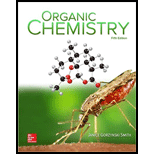
Concept explainers
(a)
Interpretation: The four possible stereoisomers of threonine by using wedges and dashes are to be drawn.
Concept introduction: Isomers are the compounds with similar formula and different structures. Stereoisomers are a type of isomers in which arrangement of atoms differ in space. Or the compounds that have same molecular formula but they differ in the arrangement of atoms or groups in the space are known as stereoisomers.
(b)
Interpretation: The structure which corresponds to an amino acid with
Concept introduction: The stereochemistry of the compound is determined by prioritizing the groups attached to its stereogenic center. The groups are prioritized on the basis of
Want to see the full answer?
Check out a sample textbook solution
Chapter 19 Solutions
Package: Organic Chemistry with Connect 2-year Access Card
- Draw the structure of the stereoisomer of ephedrine where its two stereogenic centers are of R configuration. Hello good morning, I hope you can help me with this question a little complicated for me.arrow_forwardLeuprolide is a synthetic nonapeptide used to treat both endometriosis in women and prostate cancer in men. (a) Both C-terminal and N-terminal amino acids in leuprolide have been structurally modified. Identify the modifications. (b) One of the nine amino acids in leuprolide has d stereochemistry rather than the usual L. Which one? (c) Write the structure of leuprolide using both one- and three-letter abbreviations. (d) What charge would you expect leuprolide to have at neutral pH?arrow_forward(b) How many reducing and non reducing does O- a-D-glucopyranofil(l ➔2)BETA -D-fructofuranoside has? Explain with a hawthron projectionarrow_forward
- Label the four stereogenic centers in sorbitol as R or S. (see attached file)arrow_forwardcan you help me with the mechisium and arrow pushing for b?arrow_forwarddraw the four stereoisomers of 2-amino-2,3-dimethylpentanoic acidin both the standard view and fisher projection. Classify each stereocenter as R or S and eachstereoisomer as D- or L-. Add why you classified them.arrow_forward
- If anisole is allowed to sit in D2O that contains a small amount of D2SO4, what products are formed?arrow_forwarda. Draw a three-dimensional structure for the following steroid. b. What is the structure of the single stereoisomer formed by reduction of this ketone with H2, Pd-C? Explain why only one stereoisomer is formed.arrow_forwardAn unknown substance is found to be soluble in water and gives a positive 2,4- DNP test. If you observe a yellow color after performing the iodoform test, what specific functional group must be present in the unknown?arrow_forward
